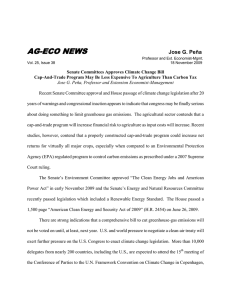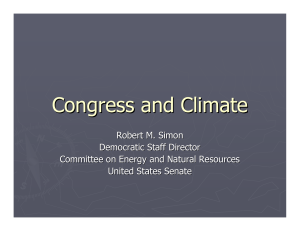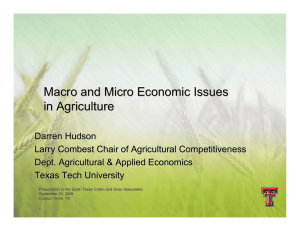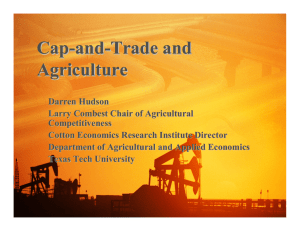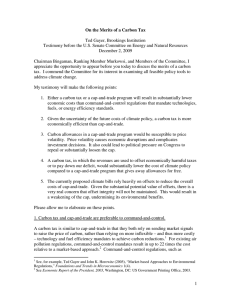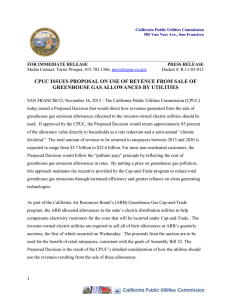AG-ECO NEWS Jose G. Peña
advertisement
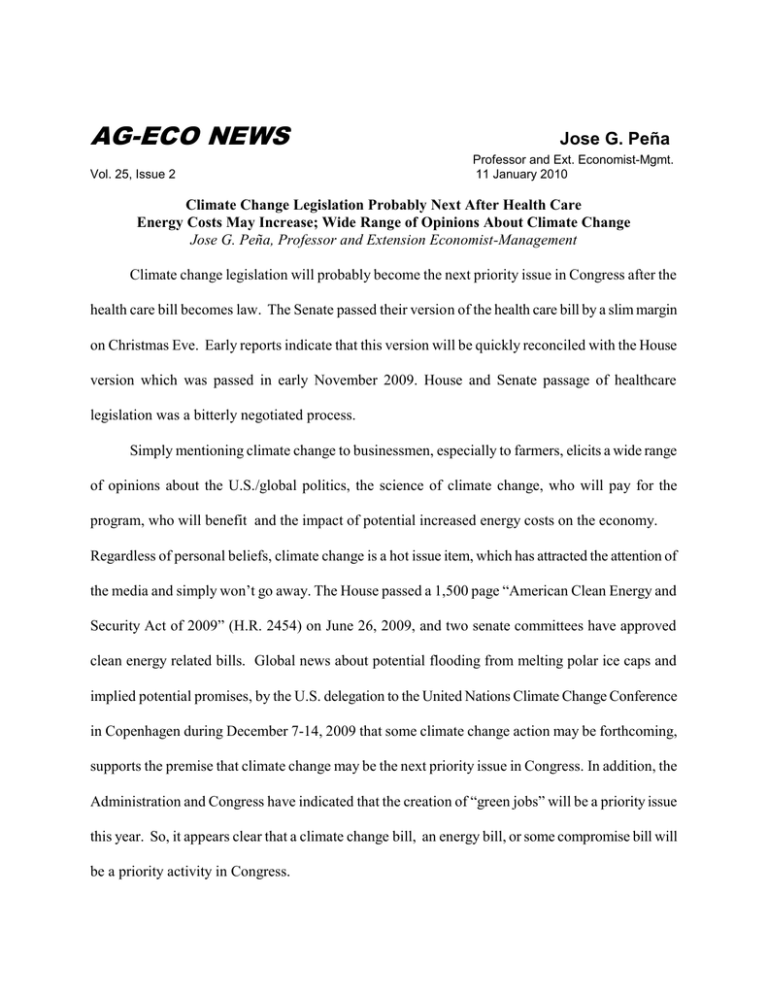
AG-ECO NEWS Vol. 25, Issue 2 Jose G. Peña Professor and Ext. Economist-Mgmt. 11 January 2010 Climate Change Legislation Probably Next After Health Care Energy Costs May Increase; Wide Range of Opinions About Climate Change Jose G. Peña, Professor and Extension Economist-Management Climate change legislation will probably become the next priority issue in Congress after the health care bill becomes law. The Senate passed their version of the health care bill by a slim margin on Christmas Eve. Early reports indicate that this version will be quickly reconciled with the House version which was passed in early November 2009. House and Senate passage of healthcare legislation was a bitterly negotiated process. Simply mentioning climate change to businessmen, especially to farmers, elicits a wide range of opinions about the U.S./global politics, the science of climate change, who will pay for the program, who will benefit and the impact of potential increased energy costs on the economy. Regardless of personal beliefs, climate change is a hot issue item, which has attracted the attention of the media and simply won’t go away. The House passed a 1,500 page “American Clean Energy and Security Act of 2009” (H.R. 2454) on June 26, 2009, and two senate committees have approved clean energy related bills. Global news about potential flooding from melting polar ice caps and implied potential promises, by the U.S. delegation to the United Nations Climate Change Conference in Copenhagen during December 7-14, 2009 that some climate change action may be forthcoming, supports the premise that climate change may be the next priority issue in Congress. In addition, the Administration and Congress have indicated that the creation of “green jobs” will be a priority issue this year. So, it appears clear that a climate change bill, an energy bill, or some compromise bill will be a priority activity in Congress. Most agree that a comprehensive climate change bill will increase energy costs, especially for agriculture. Agriculture is an energy intensive industry, highly dependent on fuel and fertilizer inputs. But, while other industries will have to directly bear the potential additional costs of a mandatory climate change program, agriculture could off-set some of the additional costs through a properly prepared cap-and-trade system as proposed by the House version of the climate change bill. Climate Change legislations will probably impose limits on the amount of Greenhouse Gas (GHG) emissions, (primarily carbon dioxide, but includes other gasses) emitted into the atmosphere from cars, power plants, factories, etc. The Senate has not fully considered the climate change legislation, but under the House passed version of the bill, the agriculture and forestry sectors are clearly exempt from the bill’s greenhouse gas emission reduction requirements. If a full or partial climate change bill is enacted it appears clear that the provisions will focus on the free-market to implement emission reductions. Economists contend that the best way to curb climate-changing emissions is through the market. Establishing a carbon market requires buyers and sellers and a means to trade (buy and sell) the emissions by establishing carbon credits and carbon offsets. The concept of carbon credits for agriculture is through carbon sequestration since carbon dioxide (CO2) from the atmosphere is absorbed by trees, plants and crops through photosynthesis, and stored as carbon in biomass (tree trunks, branches, foliage and roots) and soils. A Carbon Credit Program would allow Ag producers and landowners to earn income by storing carbon in their soil through adoption of conservation tillage practices, permanent establishment of grassland or pastureland, adoption of established native range management practices, and tree plantings on land previously used for non-forestry or degraded land (i.e., afforestation) or reestablishment of trees on lands that were previously forested (i.e., reforestation). A cap-and-trade system is the basis of the carbon trading mechanism. A Cap is a legal emission limit, established by a regulatory authority. Trade, on the other hand, means that, by law, companies may swap among themselves the permission to emit greenhouse gasses. In other words, a market for pollution permits would be established through the use of carbon credits and carbon offsets. Carbon markets are already operating on a voluntary basis. Passage of a bill could make the system mandatory. Numerous studies have analyzed the potential cost/benefit relationship of a cap-and-trade program. A preliminary analysis of the effects of HR 2454 (House Climate Change Bill) on U.S. agriculture conducted in July 2009 by the Office of the Chief Economist, Economic Research Service, USDA concluded that costs to agriculture would rise in the short term but would lead to higher agricultural incomes in the longer term, even without the carbon offsets. A study by the Agricultural and Food Policy Center (AFPC) at Texas A&M University concluded that 71 out of 98 farms in the study group would have lower ending cash reserves under the House climate bill, relative to a baseline. Another study by Agricultural Policy Analysis Center, Department of Agricultural Economics, University of Tennessee, concluded that under a properly constructed cap-and-trade program, net returns for virtually all major agricultural crops would be positive. Appreciation is expressed to Stan Bevers, Profession and Extension Economists, for his contribution to and review of this article
